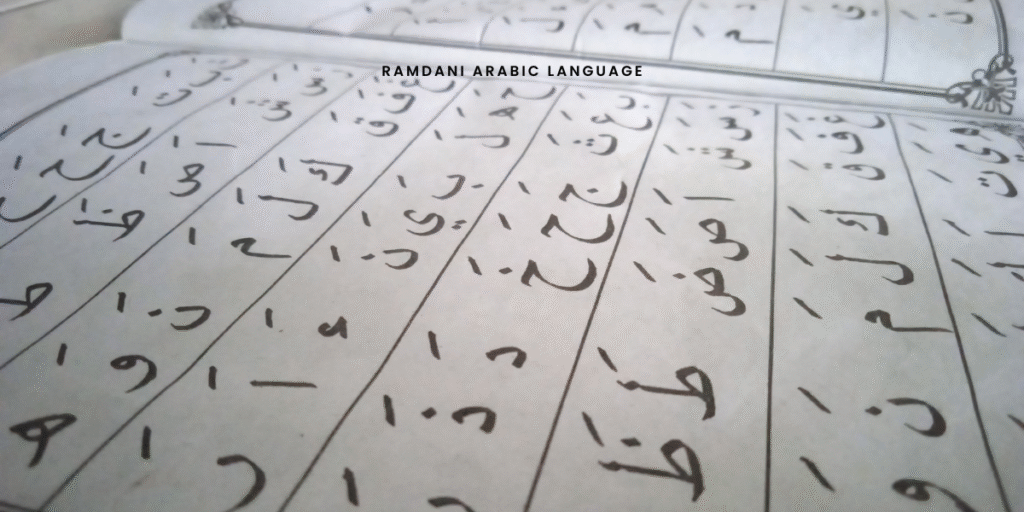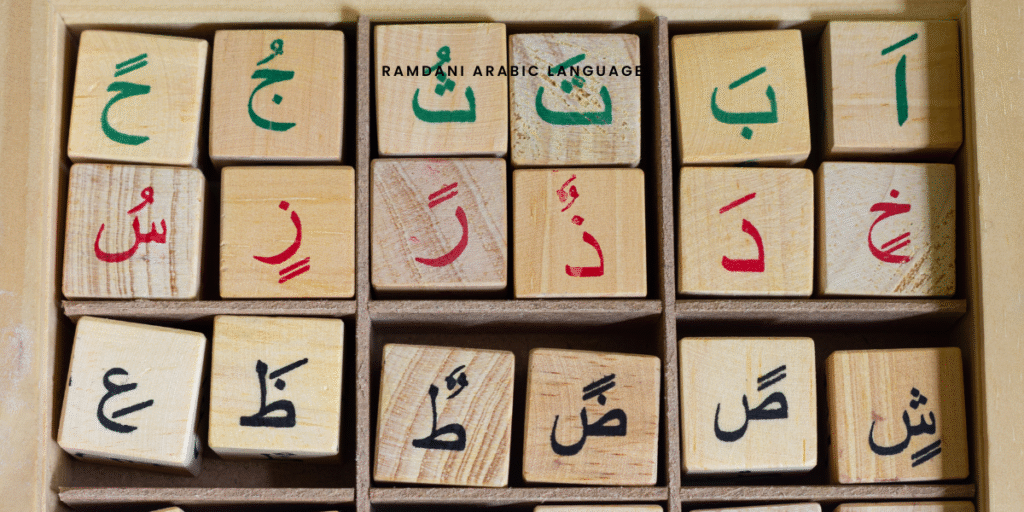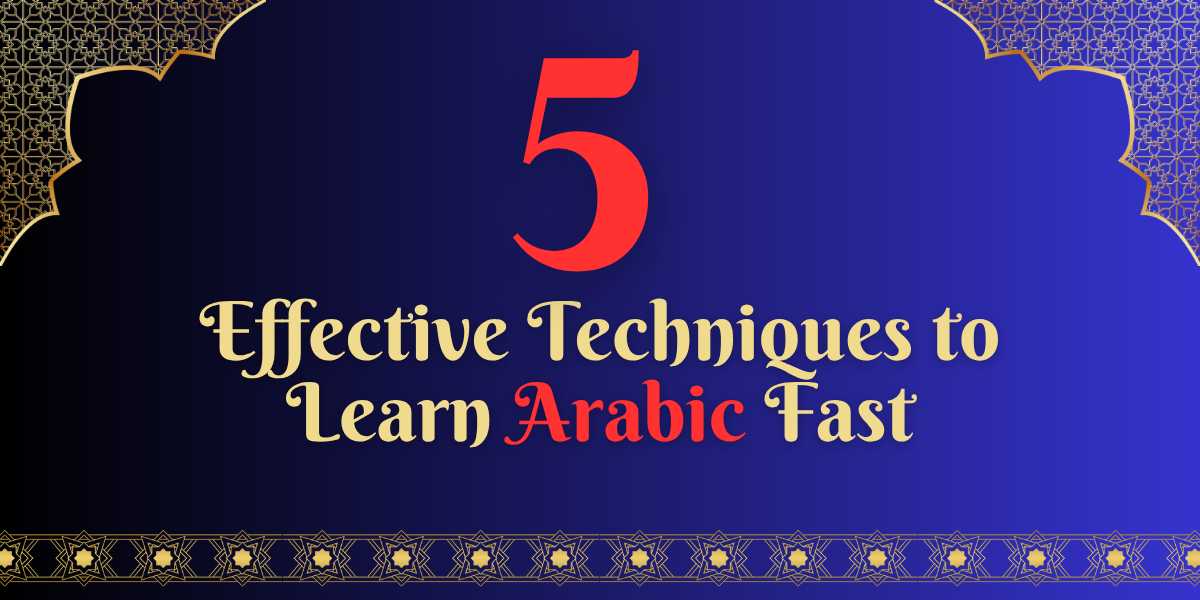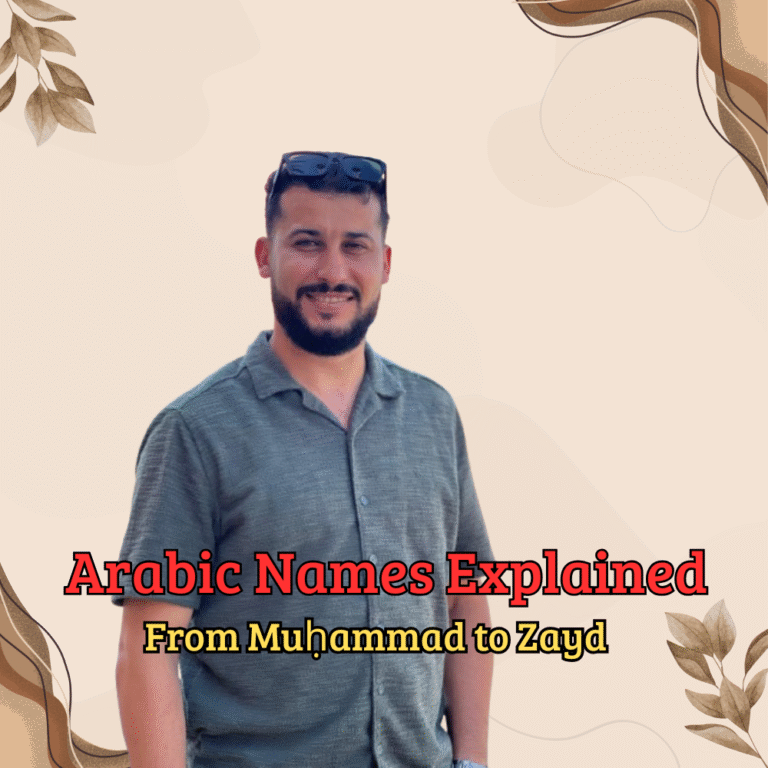Five Effective Techniques to Learn Arabic Fast 2026
Learning Arabic can feel like a big challenge. The language has its own script, grammar, and sounds that are very different from English or other European languages. Many people start learning it full of energy, then lose motivation when they realize progress feels slow. The truth is, Arabic is not harder than other languages, but it does demand the right approach. When you use effective techniques, you can move forward faster and enjoy the process.
Arabic is one of the most widely spoken languages in the world. More than 400 million people use it in their daily lives across the Middle East and North Africa. It is also the language of a rich cultural heritage that includes poetry, philosophy, science, and religion. If you learn Arabic, you open doors to new opportunities. You gain the ability to communicate with millions of people, read texts in their original form, and understand a culture that has shaped history for centuries.
For learners today, the internet makes things easier. You do not need to live in an Arabic-speaking country to get exposure to the language. Online resources, courses, and communities give you access to teachers, practice partners, and study materials from anywhere. Still, the challenge remains: how do you learn fast without getting lost in all the information available? That is the key question.
Fast learning does not mean skipping the basics or taking shortcuts. It means learning in a smart and focused way. You need a clear method, consistent practice, and techniques that match how people really absorb a new language. Many learners waste time repeating the same mistakes, such as memorizing vocabulary lists without context or focusing only on grammar rules without practicing real conversation. These methods lead to frustration. A better way is to use proven techniques that combine practice, exposure, and structure.
Think about David, a university student from London who wanted to read Arabic literature. He spent his first months only memorizing grammar charts. When he tried to read a simple text, he struggled and lost confidence. His progress changed when he switched to a method that focused on listening and speaking first. In a few weeks, he could hold short conversations, and this motivated him to keep going.
Or take Aisha, a business professional from Malaysia who needed Arabic for work. She learned quickly by practicing with native speakers online every day. She didn’t focus on being perfect, but on using the language in real situations. Within months, she was able to introduce herself, explain her job, and build trust with colleagues in the Middle East.
Stories like these show that fast progress is possible when you combine motivation with the right approach. The most successful learners know their reason for studying and choose techniques that help them stay consistent.
In this article, we will explore five techniques that can help you learn Arabic faster. Each one is practical and can be adapted to your personal goals. They are based on what successful learners and language teachers recommend, and on methods that have worked for many students at Ramdani Arabic Academy. You will see that progress comes when you focus on skills that matter most: listening, speaking, reading, and writing, while also building cultural understanding.
The goal is not just speed, but balance. You want to move quickly, but also build a strong foundation that lasts. By the end of this article, you will have a roadmap that shows how to combine modern tools, daily habits, and effective learning strategies to make Arabic part of your life.

Technique One
The fastest way to learn a language is to surround yourself with it every day. When you create an environment where Arabic becomes part of your routine, progress comes naturally. You hear the sounds more often, you recognize patterns, and you build comfort with the language. Immersion does not mean moving to Cairo or Riyadh. You can build immersion at home using simple strategies.
Start with listening. Make Arabic a background sound in your life. Play Arabic podcasts, radio stations, or YouTube videos while cooking, commuting, or walking. At first, you may not understand much, but your brain is learning to process the rhythm, tone, and flow of the language. Over time, repeated listening makes words and expressions familiar. Think of it as training your ear. The more input you get, the faster you can connect meaning to sound.
Music is another powerful tool. Many learners remember their first Arabic songs long after they forget vocabulary lists. Music connects words with emotion and memory. Choose artists from different Arab countries to expose yourself to various accents. For example, Lebanese music often uses clear Modern Standard Arabic in lyrics, while Egyptian songs can help you get used to the most widely understood dialect. Sing along, even if your pronunciation is not perfect. Repetition and rhythm help the words stick.
Reading should also be part of your daily immersion. Begin with children’s books, graded readers, or online articles designed for learners. They give you short texts with simple grammar and common vocabulary. As you get more confident, move to newspapers, blogs, or novels. Reading develops your ability to recognize words quickly and builds a larger vocabulary. A small habit like reading one short article or a few paragraphs daily makes a difference over weeks and months.
Technology makes immersion easier. Change your phone or computer settings to Arabic. It forces you to see the script every time you use your device. At first, this feels uncomfortable, but it is an effective way to connect Arabic with daily life. You will begin to recognize common words like settings, messages, and notifications without studying them directly.
Social media is another tool. Follow Arabic accounts on Instagram, Twitter, or TikTok. The posts are short, visual, and repeated often. This combination of image and text builds natural connections. You also get exposure to slang and real-life expressions that may not appear in textbooks.
Speaking should never be left aside. Even if you live in a non-Arabic environment, you can practice speaking daily. Record yourself reading a short text, then compare your voice with a native speaker’s audio. Use language exchange apps to connect with Arabic speakers who want to learn your language. Speak for five or ten minutes every day. Small, consistent practice builds confidence faster than waiting for the “right time” to speak.
A key point is consistency. One hour once a week will not create immersion. Ten to twenty minutes every day has more impact. Think about how children learn their first language. They are not taught in lessons for one hour a week; they are surrounded by it constantly. You can apply the same principle by filling your daily environment with Arabic.
Consider Sarah, an American student who wanted to learn Arabic while studying engineering. She didn’t have access to Arabic classes at her university, so she created her own immersion plan. She listened to Arabic news in the morning, practiced five minutes of conversation on an app at lunch, and read children’s stories before bed. After six months, she could understand basic conversations and hold simple discussions. She never traveled abroad, yet immersion brought her results.
When you immerse yourself daily, Arabic stops being a subject you “study” and becomes part of your life. You no longer separate learning time from living time. Every song, post, or conversation becomes a lesson. This habit builds both speed and confidence.
The first step to learning Arabic fast is not to study harder, but to create an environment where Arabic surrounds you. Once you do this, the other techniques build on it more easily.

Technique Two
One of the biggest mistakes Arabic learners make is waiting too long to speak. They spend months studying grammar and memorizing vocabulary, but when the time comes to have a real conversation, they freeze. If you want to learn fast, you must start speaking from the first day.
Speaking does two important things. First, it forces you to use the words you know instead of just recognizing them. Second, it helps you build confidence. The earlier you begin, the less fear you feel about making mistakes. Language is communication, not perfection. When you speak often, your brain learns to connect sounds, words, and meaning much faster.
Start small. You don’t need to have long conversations in the beginning. Learn basic phrases like greetings, introductions, and common questions. Say them out loud to yourself every day. Repeat them until they feel automatic. Once they do, add a few new sentences. Slowly, you build a bank of expressions you can use without thinking.
Practice with yourself if no one else is available. Record short voice notes describing your day, what you are doing, or what you see around you. Then listen back and notice your pronunciation. Compare it with how native speakers say the same words. This simple habit builds both accuracy and fluency.
When you are ready, practice with real people. Use language exchange apps to find Arabic speakers who want to learn your language. This creates a fair trade. You spend part of the time speaking in Arabic and part in your native language. You help each other, and you also gain insight into cultural expressions that textbooks cannot teach.
If you prefer a structured approach, work with a tutor online. Even one or two short sessions a week can make a big difference. A tutor helps correct your mistakes in real time and introduces useful vocabulary for your personal goals. For example, if you need Arabic for travel, you can focus on directions, food, and shopping. If you need it for work, you can practice professional conversations.
Fluency grows with repetition. Do not focus on being perfect in every sentence. Focus on making yourself understood. Mistakes are not a sign of failure; they are part of the process. The more mistakes you make and correct, the faster you improve. Think of each mistake as proof that you are pushing yourself forward.
Consider Mark, a French student who joined Ramdani Arabic Academy. At first, he was nervous about speaking and wanted to wait until he “felt ready.” His teacher insisted that he begin with short dialogues from day one. Within a month, Mark could introduce himself, ask about someone’s family, and order food in Arabic. He wasn’t fluent yet, but the early focus on speaking gave him confidence that kept him motivated.
Another example is Fatima, a medical student in Indonesia. She practiced with voice notes every night, even when she had no partner. After three months, she joined an online conversation group. She was surprised to find that she could follow most of the discussion and even add her own comments. Her progress came from the habit of daily speaking, not from endless grammar drills.
Speaking also connects you to the culture. When you hear yourself using Arabic in real conversation, you feel closer to the people and traditions behind the language. It turns study into experience. That emotional connection makes learning enjoyable and sustainable.
If your goal is to learn Arabic fast, don’t wait for a perfect moment. Start speaking today, even if all you can say is “Hello, my name is…” Each word you speak takes you closer to fluency. Combine this with daily immersion, and your progress will multiply.
Technique Three
Vocabulary is the building block of any language. Without words, you cannot read, listen, or speak. Many learners believe the fastest way to grow vocabulary is by memorizing long lists. They write dozens of words on flashcards and repeat them until they stick. The problem is that these words often disappear after a few days. You remember them for a test, but not for real conversation.
The key to learning vocabulary fast and keeping it is context. Context gives meaning to words. When you see or hear a word inside a sentence, story, or situation, your brain connects it with an image, sound, or feeling. That connection makes the word easier to remember and easier to use later.
Start with short sentences instead of isolated words. Instead of learning the word “book” alone, learn the full sentence: “I read a book.” Add another: “This book is interesting.” By repeating full sentences, you learn not only the word but also how it fits with others. When you need it later, the phrase comes naturally.
Reading is one of the best ways to collect vocabulary in context. Choose materials slightly above your current level. Highlight new words, but don’t stop at translation. Look at the whole sentence. Ask yourself: How is this word used? What words often appear before or after it? For example, in Arabic, the word for “eat” is often connected with food items like bread, rice, or meat. Seeing these patterns helps you use the word correctly.
Listening also builds vocabulary through context. Watch short Arabic videos or listen to podcasts. When you hear a new word, note the sentence around it. Even if you cannot catch every word, focus on how the new term fits the situation. Did the speaker sound happy, serious, or surprised? Did the word come before a verb or after an adjective? These small clues give the word a stronger meaning in your mind.
Repetition is important, but it must be smart. Don’t just repeat words mechanically. Repeat them in different sentences. Use them in your own speech or writing. For example, if you learn the word “market,” try to create three or four sentences: “I went to the market yesterday.” “The market is near my house.” “The market sells vegetables.” This variety strengthens memory.
Technology can help. Many apps use spaced repetition, which reminds you of words just before you forget them. To make this more effective, don’t use single-word flashcards. Add full sentences or short phrases. This way, each review reminds you of the context as well.
Stories from learners show the difference. Ahmed, a German student, spent six months memorizing vocabulary lists. He knew hundreds of words, but when he tried to speak, he could not connect them into sentences. After switching to learning phrases and reading short stories, he noticed real progress. He could retell stories in his own words and use the vocabulary naturally.
On the other hand, Leila, a Canadian learner, built her vocabulary by watching Arabic TV dramas with subtitles. She paused when she heard a new word, wrote it down with the sentence, and repeated it the next day. The context of the scene—whether it was an argument, a joke, or a family discussion—helped her remember. Months later, she could use those same words in real conversations.
Building vocabulary through context also teaches you culture. Words carry meaning beyond translation. For example, Arabic has many ways to greet people depending on time of day, formality, or religion. Learning these greetings in real situations teaches you not just the words but the social rules behind them.
If you want to learn Arabic fast, focus less on how many words you memorize and more on how deeply you understand them. A smaller set of words used correctly in context is more powerful than a large list you cannot recall. Make context your guide, and vocabulary will stop being a struggle and start becoming a natural part of your language use.

Technique Four
Many learners get stuck on Arabic grammar. The language has rules that seem complex at first: verb forms, gender, cases, and sentence structure. Some students spend months trying to master grammar before they even start speaking. This slows them down and kills motivation. If your goal is to learn Arabic fast, grammar should not be a wall in your way. It should be a tool you use when needed.
The first step is to change how you think about grammar. Do not see it as a subject you must memorize like math formulas. See it as a guide that helps you build sentences more clearly. For example, when you learn that adjectives in Arabic follow the nouns they describe, you don’t need to memorize hundreds of rules. You just need to practice with a few examples until it becomes natural.
Focus on the basics first. Learn how to form simple sentences in the present tense. Practice saying “I eat,” “I study,” “I go.” Then move to past and future. Avoid diving into advanced grammar topics like case endings or rare verb forms in the beginning. They are useful later, but not necessary for basic communication.
Grammar becomes easier when you combine it with speaking and writing. Instead of reading a rule and stopping there, use it immediately. If you learn the rule for making plurals, write five sentences using plural words. Say them out loud. Create a small dialogue. By using the rule in real situations, you make it part of your active language.
Mistakes with grammar are normal. You may say “I goes” instead of “I go” in Arabic. Most native speakers will still understand you. The important thing is to keep practicing. Over time, your brain will adjust, and the correct form will feel natural. Fear of mistakes slows learning more than the mistakes themselves.
Stories from learners show this clearly. Tom, a student from Spain, avoided speaking because he wanted to master every rule first. After a year, he knew many grammar rules but could not hold a simple conversation. When he finally began speaking, he realized practice was the real teacher. Within months, his grammar improved faster through use than through books.
On the other hand, Huda, a learner from Nigeria, used grammar as a support. She studied one rule a week, then practiced it daily in short sentences. For example, when learning about masculine and feminine words, she labeled objects around her house and practiced saying them out loud. This active use helped her remember better than reading explanations.
Use resources wisely. A short grammar guide or a teacher’s explanation is enough to give you direction. Don’t get lost in heavy textbooks. Online lessons, visual charts, or simple grammar videos often explain rules in a way that is easier to apply. After learning the rule, move immediately to examples and practice.
Another effective technique is noticing grammar in real input. When you read or listen to Arabic, pay attention to how sentences are formed. Ask yourself: Why did the speaker use this verb form? Why is the adjective placed here? Observing grammar in action reinforces the rules without long study sessions.
Grammar should serve communication, not delay it. Think of it as a set of tools you carry in your pocket. Use the ones you need for the task at hand, and pick up more as you go. If you wait to collect every tool before building, you will never start.
If you want to learn Arabic fast, stop treating grammar as a barrier. Learn the basics, apply them in real use, and allow mistakes to guide your progress. Over time, grammar becomes an ally that supports fluency instead of blocking it.
Technique Five
The biggest difference between learners who succeed and those who give up is consistency. Arabic is not learned in one week or one month. It requires steady practice over time. Many students start with excitement, then stop after a few weeks when life gets busy. If you want to learn Arabic fast, you must create a routine and follow it with discipline.
A routine works because it removes the need to make decisions every day. When you know exactly what to do and when to do it, you spend less energy thinking and more energy learning. Even small habits repeated daily bring powerful results.
Start by setting clear goals. Do you want to hold a basic conversation in three months? Do you want to read short stories by the end of the year? Write your goal down. This gives direction to your routine. Without a goal, your study time becomes random and unfocused.
Break your goal into smaller steps. If your goal is to read stories, begin with learning the alphabet, then short sentences, then children’s books. If your goal is conversation, begin with greetings, then daily phrases, then simple dialogues. Each step shows progress and keeps motivation alive.
Time management is key. You do not need to study for hours every day. Even twenty to thirty minutes of focused practice is better than two hours once a week. Choose times of the day when your mind is fresh. For some people, that is early morning. For others, it is late evening. The important thing is to make it part of your daily rhythm.
Use a mix of activities. A balanced routine covers listening, speaking, reading, and writing. For example:
- Ten minutes listening to Arabic audio.
- Ten minutes practicing speaking or repeating phrases.
- Ten minutes reading or writing.
This variety prevents boredom and develops all skills together.
Accountability helps you stay on track. Share your goal with a friend, join an online study group, or work with a teacher. When someone else expects progress from you, it is harder to skip practice. Many learners at Ramdani Arabic Academy join group sessions for this reason. They know others are practicing with them, which keeps them motivated.
Track your progress. Keep a journal of what you study each day. Record short speaking samples every two weeks and listen back. You will notice improvement even when you feel stuck. Progress is not always obvious in the moment, but recordings and notes prove that your effort is working.
Learner stories show how consistency changes results. John, an engineer from the United States, tried learning Arabic three times and quit each time. He always studied for long hours at the start, then burned out. On his fourth attempt, he changed his approach. He studied twenty minutes a day, every day, with no exceptions. After six months, he could hold conversations and read simple texts. Consistency gave him what intensity never did.
Another example is Amina, a student in Turkey. She had little free time, so she practiced Arabic only during her bus rides. She listened to podcasts, repeated sentences quietly, and reviewed vocabulary. These short sessions added up. In one year, she reached an intermediate level, all without formal classes.
Consistency is not about perfection. Some days you may only manage five minutes. That is fine. What matters is that you return every day. Gaps break momentum. Even the smallest action keeps your connection with Arabic alive.
To learn Arabic fast, do not rely on motivation alone. Motivation rises and falls. Discipline and routine carry you forward when motivation is low. Build a daily system that fits your life, stick with it, and watch your skills grow.
Final words
Learning Arabic fast is not about rushing through lessons or memorizing endless vocabulary lists. It is about smart, focused methods that build skills steadily. The five techniques we covered — immersion, speaking from day one, learning vocabulary in context, using grammar as a tool, and building consistency — work together to create lasting progress.
Immersion surrounds you with Arabic in your daily life. Listening to podcasts, music, or videos, reading articles, and even changing your phone settings introduces the language naturally. Speaking from the start reinforces learning and builds confidence. Vocabulary in context helps words stick and become usable. Grammar guides sentence construction without slowing you down. And consistency ensures that learning becomes a daily habit, creating momentum that carries you forward.
Fast learning requires motivation, but motivation alone is not enough. Discipline, planning, and smart techniques turn your effort into results. Start small, focus on the essentials, and gradually increase the challenge. Celebrate small wins, like completing a short conversation or understanding a news clip. These achievements reinforce your progress and keep you moving.
At Ramdani Arabic Academy, we combine all these methods in our courses. Our lessons are designed to integrate listening, speaking, reading, and writing from the first day. We focus on real-life language, practical exercises, and consistent practice to help learners build confidence quickly. Students from around the world use our online platform to practice daily, track progress, and get feedback from experienced teachers.
Arabic is a rich and rewarding language. Learning it fast does not mean cutting corners; it means choosing the right strategies and applying them consistently. With the techniques in this article, you can make measurable progress even if you study for short periods each day.
As the founder of Ramdani Arabic Academy, I have seen thousands of learners transform their skills by applying these methods. I recommend that you start today, set clear goals, and commit to a routine that fits your life. Use immersion, speak whenever possible, learn words in context, practice grammar through use, and keep your practice consistent.
The journey may have challenges, but each small step compounds over time. With persistence and the right approach, Arabic can become not just a subject you study, but a language you live.







